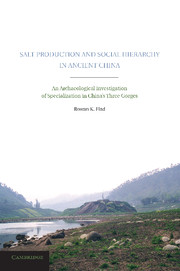 Salt Production and Social Hierarchy in Ancient China
Salt Production and Social Hierarchy in Ancient China Book contents
- Frontmatter
- Contents
- List of Figures and Tables
- Acknowledgments
- Prologue
- 1 Introduction
- 2 Production and Specialization in Complex Societies
- 3 Ancient Salt Production in Sichuan
- 4 The Zhongba Site
- 5 Ceramic Evidence
- 6 Parameters of Production According to Ceramics
- 7 Features and Spatiality
- 8 Animal Remains and Divination
- 9 Conclusions and Implications
- Epilogue
- Appendix A Chinese and Japanese Term List
- Appendix B The (t) Value and Average Thickness for Each Level Excavated in DT0202
- Appendix C Calculating the Scale of Production Using Briquetage from DT0202
- Appendix D Taxon List for Specimens Recovered from DT0202 with Number of Identified Specimens and Minimum Number of Individual Count by Phase and Subphase
- Notes
- Bibliography
- Index
4 - The Zhongba Site
Published online by Cambridge University Press: 07 September 2011
- Frontmatter
- Contents
- List of Figures and Tables
- Acknowledgments
- Prologue
- 1 Introduction
- 2 Production and Specialization in Complex Societies
- 3 Ancient Salt Production in Sichuan
- 4 The Zhongba Site
- 5 Ceramic Evidence
- 6 Parameters of Production According to Ceramics
- 7 Features and Spatiality
- 8 Animal Remains and Divination
- 9 Conclusions and Implications
- Epilogue
- Appendix A Chinese and Japanese Term List
- Appendix B The (t) Value and Average Thickness for Each Level Excavated in DT0202
- Appendix C Calculating the Scale of Production Using Briquetage from DT0202
- Appendix D Taxon List for Specimens Recovered from DT0202 with Number of Identified Specimens and Minimum Number of Individual Count by Phase and Subphase
- Notes
- Bibliography
- Index
Summary
LOCATION AND GEOGRAPHICAL SETTING
The mound of Zhongba (also known as Yangziyan) is located in group 1 of Youxi Village, Ganjing Township (37°17′14″ N, 108°1′16″ E), a little over 6 km from the confluence of the Ganjing and Yangzi rivers along a meandering river with steep slopes (Beijing ; Sichuan and Chongqing n.d.; Sichuan and Zhong 2001; Sichuan et al. 2007; Sun 1999, 2003a, 2003b, 2008; Sun and Chen 2000; Zhongguo1990). Figure 4.1 shows the locations of Zhongba on the Ganjing River and the sites along the Yangzi near the mouth of the Ganjing: Dujiayuanzi, Wazhadi, Shaopengzui, and Yajiao (Banbianjie and Luojiaqiao). After the construction of the Three Gorges Dam, the Ganjing River valley has been flooded as part of the new reservoir, submerging the Zhongba mound. Prior to this, the Zhongba mound rose over 15 m from the bottom of the meandering Ganjing River valley, just below a precipitous defile, where a slight meander in the Ganjing River is joined by a series of small tributary streams and creeks on both the right and left banks. Although both banks of the river contain some cultural remains (the total site area is about 50 ha in size), the majority of preserved strata identified by archaeological research were located on the northwestern end of an earthen mound (see Figure 4.2).
- Type
- Chapter
- Information
- Salt Production and Social Hierarchy in Ancient ChinaAn Archaeological Investigation of Specialization in China's Three Gorges, pp. 60 - 82Publisher: Cambridge University PressPrint publication year: 2011
